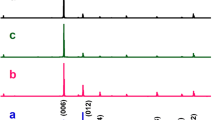Abstract
Y3+ was substituted for Ca2+ in polycrystalline CaTiO3 in amounts up to 15 at %. Sintering conditions (1450° C, 15 h) were such that grain sizes were > 25 μm. Stoichiometry was adjusted on the assumption that the excess charge of the dopant was compensated by the creation of calcium vacancies. This assumption was supported by measurements of the Ca/Ti ratio in the grains by electron-probe microanalysis. Unlike yttrium-doped SrTiO3, material sintered in air was light-coloured with no evidence of semiconductivity. On the other hand, when sintering was done in nitrogen, dielectric relaxation characteristic of boundary layers was observed for dopant levels > 1 mol %. The experimental data support the view that dielectric relaxation in SrTiO3 and CaTiO3 results from semiconducting grains with resistive surface layers and that the semiconductivity arises because oxygen loss from the grains during sintering is increased by “donor” doping.
Similar content being viewed by others
References
I. Burn and S. Neirman, J. Mater. Sci. 17 (1982) 3510.
L. Hanke and H. Schmelz, Ber. DKG 59 (1982) 221.
R. Wernicke, Phys. Status Solidi (A) 47 (1978) 139.
T. Y. Tien and L. E. Cross, Jap. J. Appl. Phys. 6 (1967) 459.
D. W. Johnson, L. E. Cross and F. A. Hummel, J. Appl. Phys. 41 (1970) 2828.
O. Saburi, J. Phys. Soc. Jap. 14 (1959) 1159.
U. Balachandran and N. G. Eror, J. Mater. Sci. 17 (1982) 1795.
R. K. Sharma, N. H. Chan and D. M. Smyth, J. Amer. Ceram. Soc. 64 (1981) 448.
P. E. C. Franken, M. P. A. Viegers and A. P. Gehring, ibid. 64 (1981) 687.
R. Wernicke, Philips Res. Reports 31 (1976) 526.
W. Heywang, J. Amer. Ceram. Soc. 47 (1964) 484.
G. I. Skanavi and E. N. Matveeva, Sov. Phys. 3 (1957) 905.
A. K. Mehrotra and D. A. Payne, Bull. Amer. Ceram. Soc. 61 (1982) 428 (Abs.).
S. Shirasaki, Y. Yamamura, H. Haneda, K. Kakegawa and J. Moori, J. Chem. Phys. 73 (1980) 4640.
S. Shirasaki, M. Tsukioka, H. Yamamura, H. Oshima and K. Kakegawa, Solid State Commun. 19 (1976) 721.
H. Brauer, Us Pat. 3 569 802 (1971).
S. Waku, Rev. Electr. Commun. Lab. 15 (1967) 689.




